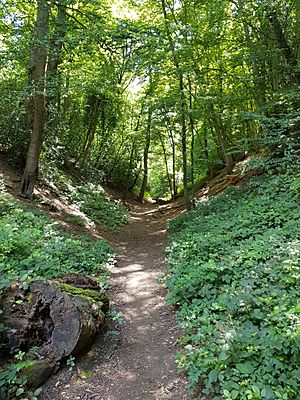Devil's Dyke, Hertfordshire facts for kids
The Devil's Dyke is an ancient defensive ditch. It is found on the east side of Wheathampstead village in Hertfordshire, England. This site is very old, dating back to the Iron Age. It is a protected historical site, meaning it's important and kept safe.
Experts believe the Devil's Dyke was part of a large fort. This fort belonged to the Catuvellauni tribe. They were an important group in ancient Britain. Some people even think it might be linked to Julius Caesar's second invasion of Britain in 54 BC.
Contents
What is the Devil's Dyke?
The Devil's Dyke is part of a much bigger area. This area was once a large, fortified settlement called an oppidum. It covered about 40 hectares (that's like 100 football fields!). Maps often show it as a "Belgic oppidum."
Archaeologists have studied the site carefully. They found that the main Devil's Dyke ditch is very deep. It was likely the strongest part of the fort's defences. Other parts of the settlement had smaller ditches. These smaller ditches might have been boundaries. Perhaps they kept animals from wandering off. They were probably not for defence against attackers.
Today, you can still see two parts of the ditch. The western part is the Devil's Dyke itself. It's about 30 metres wide and 12 metres deep at its biggest. That's like a really big trench! A smaller ditch to the east is called "The Slad". A moat also continues the line of the ditch further south. While you can visit the Devil's Dyke, The Slad is on private land. This means it's not open to the public.
The River Lea flows nearby. It might have acted as a natural barrier. This would have helped protect the northern side of the ancient settlement.
History of the Dyke
When was it built?
In the 1970s, workers found Belgic pottery. This happened when they were building a new road near the River Lea. This pottery helps us understand when the fort was used. The Catuvellauni tribe is often linked to people from ancient Belgium. Some older pottery was also found, showing the area was used even before the main fort.
Visiting and Protecting the Site
You are welcome to visit the Devil's Dyke. A sign at the entrance tells us something interesting. The land was given to the public in 1937. This was a gift from Lord Brocket. He gave it to celebrate the coronation of King George VI and Queen Elizabeth.
Other parts of the ancient fort are not open to visitors. The site is also on a list of historical places that need protection. This is because farming activities nearby could damage it over time.
Was Julius Caesar here?
Some people think the Devil's Dyke is the strong fort that Julius Caesar attacked. This happened in 54 BC. Caesar wrote about it in his own book, De Bello Gallico. However, there are other places that could also be this fort. So, we don't have definite proof that Caesar was at the Devil's Dyke.
An archaeologist named Sir Mortimer Wheeler thought Caesar attacked Wheathampstead. He dug at the site in 1932. The sign at the Dyke's entrance mentions his idea. This has made many people believe it's a fact. But so far, archaeologists haven't found any military evidence from Caesar's time in Hertfordshire.
Other Nearby Ancient Sites
Some archaeologists, like Professor Cunliffe, believe the Wheathampstead fort was connected to other ancient earthworks. One of these is Beech Bottom Dyke. It's about four miles southwest of the Devil's Dyke.
This idea suggests there was a very long defensive earthwork. It might have stretched from the River Lea to the River Ver. This could mean there was a huge enclosed settlement. These defences were probably built by King Cunobelinus. He was a powerful king of the Catuvellauni. They might have been built to mark out land around their main tribal centre. This centre was called Verlamion, which later became the Roman city of Verulamium.



